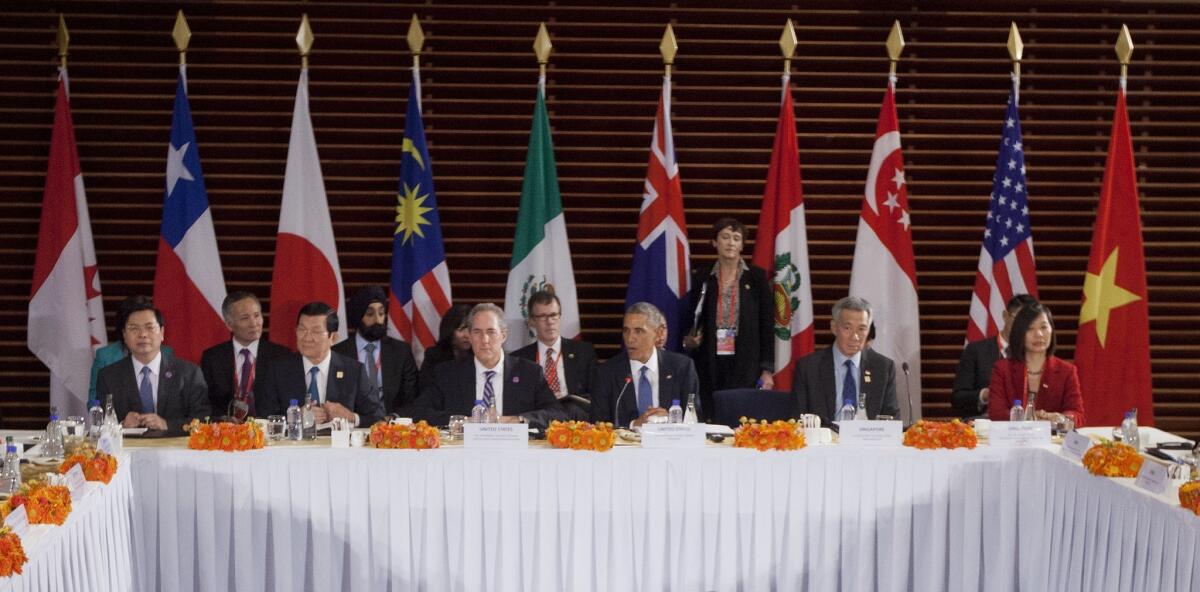Q&A:: The Trans-Pacific Partnership trade pact: What’s in it for the U.S.?

President Obama, center, speaks during his meeting with leaders of the Trans-Pacific Partnership countries in Beijing on Nov. 10, 2014.
Reporting from Washington — The United States and trade partners in 11 Pacific nations have reached a deal to link 40% of the global economy, phasing out tariffs on thousands of goods and establishing uniform rules of commerce.
Here’s a look at some common questions about the Trans-Pacific Partnership.
What is the Trans-Pacific Partnership?
The Trans-Pacific Partnership, or TPP, is a free-trade pact negotiated by 12 Pacific Rim countries. The TPP will not only reduce tariffs and other barriers to open markets, but also establish leading-edge standards on a range of issues affecting trade and international competition. For instance, negotiators agreed on new rules for intellectual property rights, government procurement and the role of the state in private enterprise.
Who is in the TPP, and who isn’t?
There are a dozen countries that in total account for almost 40% of the global economy. As the largest economy, the United States is seen as the leader. The other nations, in order of economic size, are Japan, Canada, Australia, Mexico, Malaysia, Singapore, Chile, Peru, New Zealand, Vietnam and Brunei.
Conspicuously absent from the talks is China, the world’s second-biggest economy, although it and other countries could join the TPP later.
How did TPP get started?
The negotiations had their genesis in talks that began more than a decade ago among Singapore, Chile and New Zealand. An original agreement was reached by those three countries, plus Brunei, in 2005, from which the model was adopted to the TPP and extended to other nations. The United States announced it would join the discussions in 2008. On Oct. 3, 2015, a final agreement was announced.
What’s in it for the United States?
Most economists see liberalizing trade as a benefit to the economy. The TPP has the potential to boost U.S. exports and investments by lowering tariffs and leveling the playing field in some large or rapidly growing markets. The White House has said the TPP will support many higher-paying American jobs and generate an additional $123.5 billion a year in U.S. exports by 2025 -- a relatively small percentage compared with the proportionately larger gains that would be reaped by countries such as Vietnam.
Beyond the commercial implications, many experts regard the TPP as a key part of American foreign policy. Amid the rise of China and its increasing exercise of political and military muscle in Asia, the Obama administration has said it would turn its attention more to the East, the so-called pivot to Asia, in an effort to strengthen American influence in that region. In that sense, the TPP is meant to be a counterweight to China’s growing power.
Why is the TPP controversial?
The TPP is a major multilateral trade pact, the most significant for the United States since the North American Free Trade Agreement, which took effect in 1994 among the United States, Canada and Mexico. Labor unions and other critics of NAFTA say that pact pushed many more domestic manufacturing operations to Mexico and resulted in the loss of hundreds of thousands of jobs. The U.S. Chamber of Commerce and other business interests say that NAFTA brought booming trade and greater economic integration among the three countries.
NEWSLETTER: Get the day’s top headlines from Times Editor Davan Maharaj >>
Now that the deal has been reached, what happens next?
This summer, President Obama secured trade-promotion, or fast-track, authority that will allow him to submit the trade deal to Congress for an up-or-down vote without amendments.
Under the fast-track legislation, the text of a trade agreement will be published 30 days after the president gives notice to Congress of his intent to sign the trade accord. The public has 60 days to review it, and then the International Trade Commission, an independent agency, has up to 105 days to produce an economic impact assessment. In this scenario, it would be next spring before Congress could vote on the package.
Will Congress vote for it?
It’s unclear whether Obama has enough votes, particularly in the House, to win support for his trade agenda. Obama’s biggest roadblock is coming from lawmakers in his own party, who have traditionally been suspicious of trade agreements. Although Republicans are generally supportive of free trade, some GOP lawmakers are reluctant to hand Obama a victory, particularly during the 2016 presidential election. When the deal was unveiled in October 2015, it received a surprisingly negative reception from many of the Republicans whom Obama will need to win approval.
Twitter: @dleelatimes
ALSO
Did Ben Bernanke really want to put bankers in jail? His book says no.
American Apparel files for bankruptcy; manufacturing to remain in U.S.
China left out of landmark trade deal, but door is left open for the future
More to Read
Sign up for Essential California
The most important California stories and recommendations in your inbox every morning.
You may occasionally receive promotional content from the Los Angeles Times.











